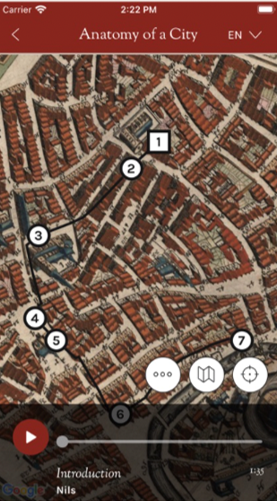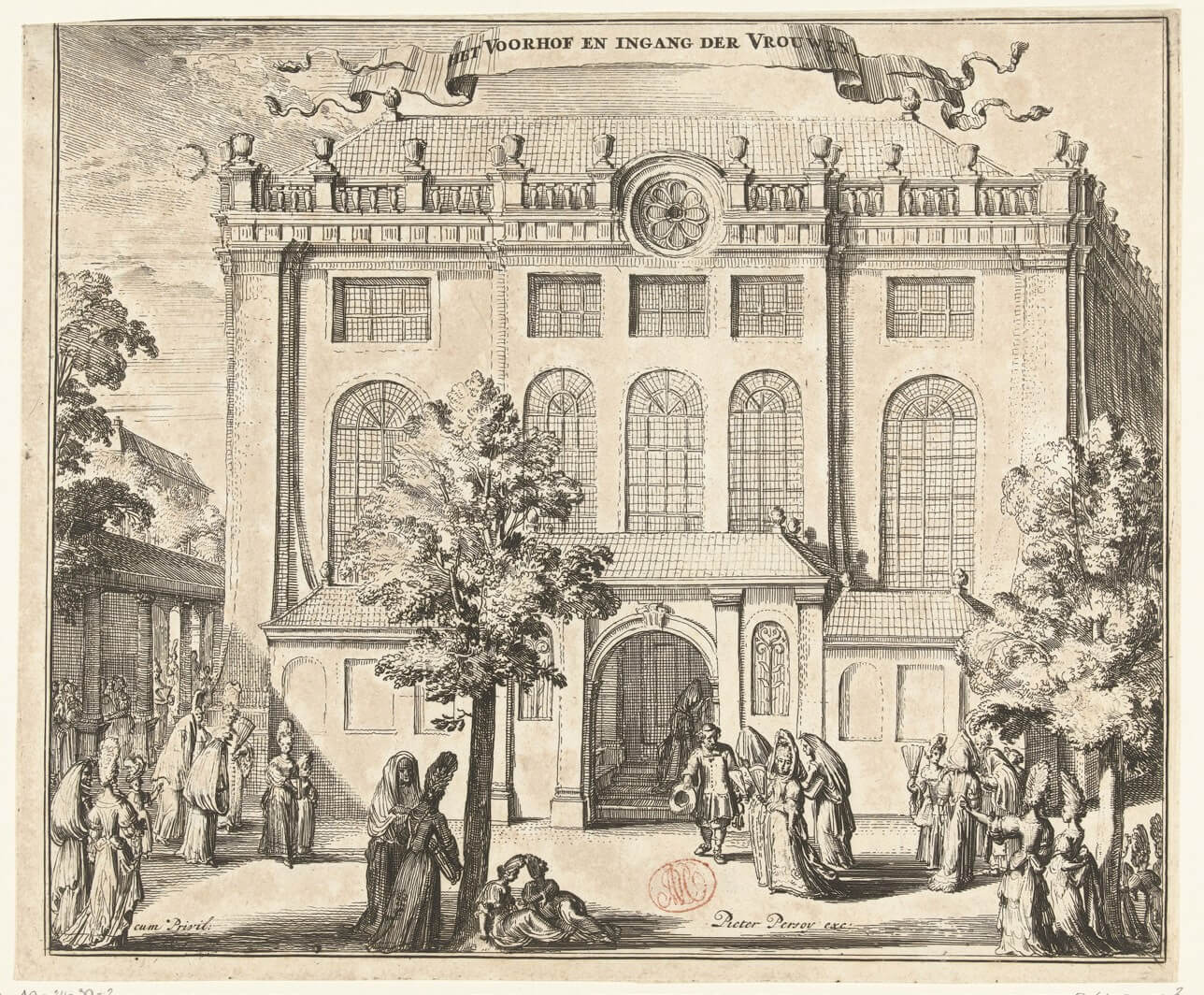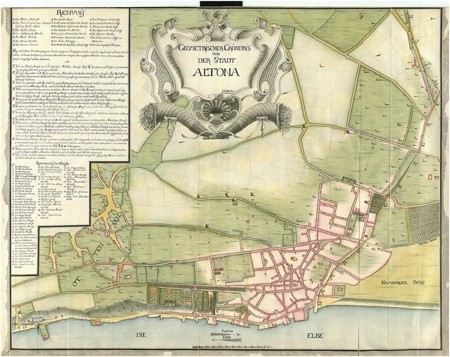Urban Space

Pieter Brueghel the elder, The fight between Carnival and Lent (1559), Museum of Fine Arts Vienna.
Early modern cities set the stage for negotiating material and cultural boundaries for privacy, in spaces within buildings, in the streets and in relation to sites outside the walls. In response to surveillance, the social use of space can be a breeding ground for both the infringement of everyday life and the need for privacy.
In present-day society, privacy is usually materialized in the opportunity to lock the door to a private room. However, anthropological research on non-western cultures, as well as research on historical societies in the west, have highlighted how people sought privacy in the outdoors. The theme URBAN SPACE seeks to answer where privacy was sought in early modern society by focusing how urban buildings and infrastructure were constructed and how people experienced and navigated them. So far, we have found that norms pertaining to privacy were present in early modern society not only in relation to new ideas about civil liberties, but also in the social fabric of the old regime. In particular, we have encountered such norms in processes of bureaucratization of urban administration, in the wake of perceived needs for improved security and navigation of the urban environment. As a response to such efforts, we have found how people addressed cases of bodily exposure, leak of information and ruined reputation as worthy of stronger protection.
The first phase of PRIVACY (2017–2023) focused on site-based interdisciplinary analysis of nine selected cities. These cases have generated studies on specific urban environments, from a street-level perspective particularly on Copenhagen, Altona, Amsterdam, and Versailles. Further cities have been in focus of contributions to edited volumes and the in-house Privacy Studies Journal. In the coming years (2023–2027), we gather forces to go beyond public-private/domestic-dichotomies by investigating how specific buildings (such as town houses, court houses, post houses, etc) have shaped notions of privacy, taking building construction, intended use, and routinized practices into account. We pursue this task with a global perspective as well as with a keen eye for what role notions of privacy have played for these buildings from the early modern period until the present day.
Selected PRIVACY Articles on Urban Space
 |
Johannes Ljungberg & Jesper Jakobsen, “The Establishment of the Police Office in mid-eighteenth Century Altona. New opportunities for privacy in transitional times?”, Urban History 2023: 1–20. |
 |
Jesper Jakobsen, Ulrik Langen, Peter Wessel Hansen & Rikke Simonsen, “From Flesh to Paper: Bodily and Material Transformations in Seventeenth-Century Copenhagen. A case study”, Urban History 2023: 1-19. |
 |
Natália da Silva Perez & Peter Thule Kristensen, ”Gender, Space, and Religious Privacy in Amsterdam”, Tijdschrijft voor Sociale en Economische Geschiedenis/Low Countries Journal of Social and Economic History, 18:3 (2021): 5–16. |
 |
Nuno Grancho, “Drawing the ‘colour line’: race, ethnicity and religion in Diu”, Journal of Race, Ethnicity and the City, 2023: 1–26. |
 |
Johannes Ljungberg, “Between Home and City: Receiving and Controlling Strangers in Altona, 1740–1765”, in in Baltic Hospitality from the Middle Ages to the Twentieth Century: Receiving Strangers in Northeastern Europe, ed. by Sari Nauman, Wojtek Jezierski, Christina Reimann & Leif Runefelt, Palgrave Macmillan 2022, 247–71. |
i) Urban regulation & surveillance
Johannes Ljungberg & Jesper Jakobsen, “The Establishment of the Police Office in mid-eighteenth Century Altona. New opportunities for privacy in transitional times?”, Urban History, FirstView 25 September 2023: 1–20.
Jesper Jakobsen, “Be Quiet! Johann Peter Willebrand on Urban Noise and the Importance of Domestic Tranquility in Eighteenth-Century Altona”, KNOW, forthcoming 2024.
Natália da Silva Perez, “Sexual surveillance in Paris and Versailles under Louis XIV”, in Histories of Surveillance from Antiquity to the Digital Era: The Eyes and Ears of Power, ed. by Andreas Marklund & Laura Skouvig, Routledge 2022, 53–69.
Ulrik Langen, “Public order and the experiment of implementing privacy in eighteenth-century Copenhagen”, in Private/Public in 18th Century Scandinavia, ed. by Sari Nauman & Helle Vogt, Bloomsbury 2022, 189–200.
Johannes Ljungberg, “Sabbath Crimes in a City of Enlightenment. Religious and Commercial (dis)order in mid-eighteenth century Altona”, in Religious Enlightenment in the Nordic Countries. Reason and Orthodoxy, c. 1680–1820, ed. by Johannes Ljungberg & Erik Sidenvall, Manchester University Press 2023, 312–40.
Mathieu Laflamme, “Entering the Bedroom through the Judicial Archives: Sexual Intimacy in Eighteenth-Century Toulouse”, in Early Modern Privacy: Sources and Approaches, ed. by Michaël Green, Lars Cyril Nørgaard & Mette Birkedal Bruun, Brill 2021 , 194–212.
Sari Nauman, “’You Cannot pass’: The reception and rejection of a stranger in Helsingborg 1744”, in Migrants and the Making of the Urban-Maritime World. Agency and Mobility in Port Cities, c. 1570–1940, ed. by Christina Reimann & Martin Öhman, Routledge 2020, 129–52.
-
ii) Urban experience & interaction
Jesper Jakobsen, Ulrik Langen, Peter W. Hansen & Rikke Simonsen, “From Flesh to Paper: Bodily and Material Transformations in Seventeenth-Century Copenhagen. A case study”, Urban History, FirstView 20 November 2023: 1–19. This article is made virtual in an app and with participation of professional actors here: HIDDEN COPENHAGEN
Natália da Silva Perez & Peter Thule Kristensen, ”Gender, Space, and Religious Privacy in Amsterdam”, Tijdschrijft voor Sociale en Economische Geschiedenis/Low Countries Journal of Social and Economic History, 18:3 (2021): 5–16.
Valleria De Lucca & Christine Jeanneret, “Exploring the Soundscape of Early Modern Rome through Uberti’s Contrasto musico”, in The Grand Theatre of the World: Music Space, and the Performance of Identity in Early Modern Rome, ed. by Valeria De Lucca & Christine Jeanneret, Routledge 2020, 11–30.
Nuno Grancho, Fabio Colonnese & Robin Schaeverbeke (eds.), Approaches to Drawing in Architectural and Urban Design, 2023 to Cambridge Scholar Publishing, forthcoming 2024.
Virginia Reinburg, “Talking About Religion During Religious War: Gilles de Gouberville, Normandy, 1562”, in Tracing Private Conversations in Early Modern Europe. Talking in Everyday Life, ed. by Johannes Ljungberg & Natacha Klein Käfer, Palgrave Macmillan 2024, 33–57.
Krisztina Péter, “’Alone amongst ourselves’: How to Talk in Private According to the Cologne Diarist Hermann von Weinsberg (1518–94)”, in Tracing Private Conversations in Early Modern Europe. Talking in Everyday Life, ed. by Johannes Ljungberg & Natacha Klein Käfer, Palgrave Macmillan 2024, 117–143.
Jelena Bakic, “The Eastern Adriatic and Privacy in Sixteenth-Century Italian Travel Narratives”, in Privacy at Sea, ed. by Natacha Klein Käfer, Palgrave Macmillan 2024, 345–372.
Natalie P. Körner & Johannes Ljungberg, ”Experiencing Intrusion: Smashed Windows as Violations of Privacy in the University Town of Helmstedt, 1684–1706”, Architectural Histories 2023.
Dag Lindström & Göran Tagesson, “Spaces for comfort, seclusion and privacy in a Swedish eighteenth-century town”, in Private/Public in 18th Century Scandinavia, ed. by Sari Nauman & Helle Vogt, Bloomsbury 2022, 141–62.
Valeria Viola, “Secret Routes and Blurring Borders: The New Apartment of Guiseppe Papè di Valdina (Palermo, 1714–1742)”, in Early Modern Privacy: Sources and Approaches, ed. by Michaël Green, Lars Cyril Nørgaard & Mette Birkedal Bruun, Brill 2021 , 401–22.
Tom-Erik Krijger, “An Extraterritorial Privacy Zone? Dutch Protestants and their Embassy Chapel in Early Modern Portugal”, Tijdschrijft voor Sociale en Economische Geschiedenis/Low Countries Journal of Social and Economic History, 18:3 (2021): 41–74.
iii) Public and private roles & networks
Johannes Ljungberg, “Between Home and City: Receiving and Controlling Strangers in Altona, 1740–1765”, in in Baltic Hospitality from the Middle Ages to the Twentieth Century: Receiving Strangers in Northeastern Europe, ed. by Sari Nauman, Wojtek Jezierski, Christina Reimann & Leif Runefelt, Palgrave Macmillan 2022, 247–71.
Adam Horsley, “When Private Speech Goes Public: Libertinage, Crypto-Judaic Conversations, and the Private Literary World of Jean Fontanier, 1621”, in Tracing Private Conversations in Early Modern Europe. Talking in Everyday Life, ed. by Johannes Ljungberg & Natacha Klein Käfer, Palgrave Macmillan 2024, 59–80.
Nele De Raedt, “Belonging to the Individual or the Collective? The Urban Residence as a Public/Private Building in Renaissance Italy (1300–1500)”, Privacy Studies Journal 2, 2023: 35–50.
Thea Sumalvico, “How Private is Religion? Theological Debates on Private and Public Religion as a Background for Woellner’s Edict on Religion in Late-Eighteenth-Century Prussia”, KNOW: Creation, Control, Communication: A Historical Appraisal of Privacy in Knowledge Production, ed. by Natália da Perez Silva & Natacha Klein Käfer, Spring 2023: 11–34.
Bob Pierik, “Privacy, Publicity, and Gender in Amsterdam's Early Modern Urban Space”, Privacy Studies Journal 1, 2022: 1–24.
Martin Almbjär, “Au carrefour des intérëts: Les maisons consulaires suédoises en Espagne au XVIIIe siècle”, in La maison consulaire: Espace, fonctions et usagers xvie–xiie siècles, ed. by Mathieu Grenet, Presses Universitaires de Provence 2021, 75–94.
Ivana Bičak, ”Chops and Chamber Pots: Satire of the Experimental Report in Seventeenth-Century England”, in Early Modern Privacy: Sources and Approaches, ed. by Michaël Green, Lars Cyril Nørgaard & Mette Birkedal Bruun, Brill 2021 , 266–80.
Michaël Green, “Public and Private in Jewish Egodocuments of Amsterdam (ca. 1680–1830)”, in Early Modern Privacy: Sources and Approaches, ed. by Michaël Green, Lars Cyril Nørgaard & Mette Birkedal Bruun, Brill 2021 , 213–42.
-
iv) Information flows & reputation
Jesper Jakobsen, “Commercial newspaper and public shame pole: Exposure of individuals in the Copenhagen gazette Adresseavisen 1759–73”, in Private/Public in 18th Century Scandinavia, ed. by Sari Nauman & Helle Vogt, Bloomsbury 2022, 99–118.
Camilla Schjerning, “Of chamber pots and scorned houses: Exposing hidden bodies and private matters in eighteenth-century Copenhagen”, in Private/Public in 18th Century Scandinavia, ed. by Sari Nauman & Helle Vogt, Bloomsbury 2022, 119–38.
Cristina Sasse, “’A Proper Direction to Their Places of Abode’: Street Addressing and Wayfinding in England, ca. 1650–1850”, KNOW: Creation, Control, Communication: A Historical Appraisal of Privacy in Knowledge Production, ed. by Natália da Perez Silva & Natacha Klein Käfer, Spring 2023: 91–112.
Holly Day, “’Memorandums, of No Use to Any but the Owner’: Finding Value in Eighteenth-Century Pocket Memorandum Books”, KNOW: Creation, Control, Communication: A Historical Appraisal of Privacy in Knowledge Production, ed. by Natália da Perez Silva & Natacha Klein Käfer, Spring 2023: 137–68.
-
v) Colonial encounters
Nuno Grancho, “Shared spaces and absent divides. Urban Identity and Spatial Dynamics of Colonial Urbanism under Portuguese, French and Danish Rules: Diu, Pondicherry and Tranquebar” in The Routledge Companion to Art and Empire Imperialism and Aesthetic Practices, 1865-1945, ed. by Alice Price and Emily Burns, Routledge, forthcoming February 2024.
Nuno Grancho, “Subaltern Drawings: Can Architecture, Urbanism and Fieldwork strike back?”, in Approaches to Drawing in Architectural and Urban Design, ed. by Nuno Grancho, Fabio Colonnese & Robin Schaeverbeke, Cambridge Scholar Publishing, forthcoming 2024.
Natália Da Silva Perez, ”Privacy in Recife, Freedom in Amsterdam: Juliana’s practical strategies of autonomy across the Atlantic”, in Privacy at Sea, ed. by Natacha Klein Käfer, Palgrave Macmillan 2024, 77–97.
Alessia Ceccarelli, “The Spinola System for Maritime Postal Exchanges between the Madrid Nunciature and the Roman Curia”, in Privacy at Sea, ed. by Natacha Klein Käfer, Palgrave Macmillan 2024, 199–252.
Nuno Grancho, “Drawing the ‘colour line’: race, ethnicity and religion in Diu”, Journal of Race, Ethnicity and the City, 2023: 1–26.
Partner Theme Projects
HIDDEN COPENHAGEN (Jesper Jakobsen, Ulrik Langen, Peter Wessel Hansen & Rikke Simonsen) as a part of HIDDEN CITIES
INDIABRIDGE (Nuno Gracho)
IBridge (Solmaz Sadeghi)
SOUND (Christine Jeanneret)
Introduction to theme leader, Johannes Ljungberg

|
I am an Associate Professor of history, specialized on notions of privacy in urban space and private communication, as well as religiously dissenting networks in the Lutheran North stretching across confessions, communities, and state borders. Currently I co-lead a project on privacy in early modern buildings together with Natalie P. Körner. I also study the intertwinement of privacy as a human right and a research concept from 1948 and the following decades. Read more about my research here. |
